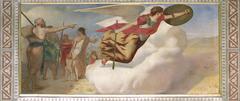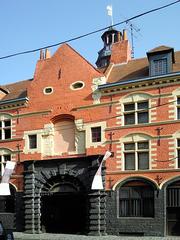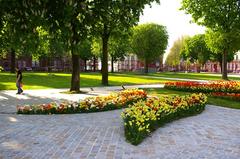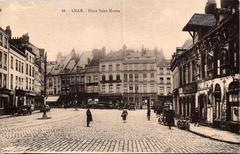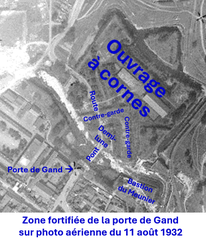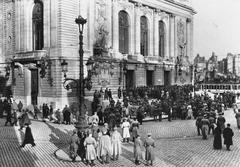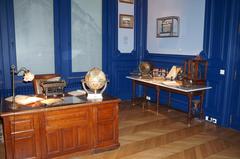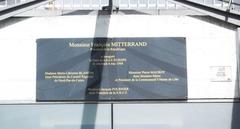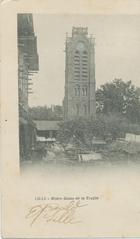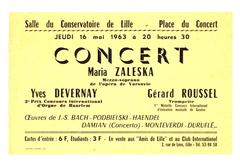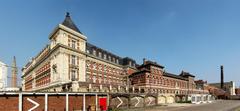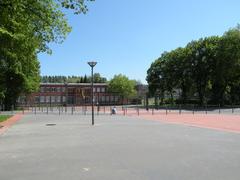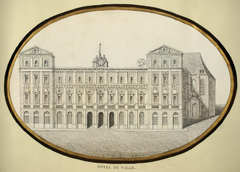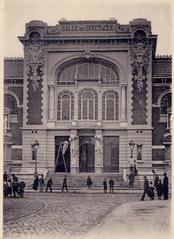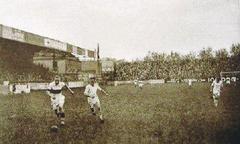Porte des Postes Lille: Visiting Hours, Tickets, and Historical Site Guide
Date: 04/07/2025
Introduction
Lille, the vibrant capital of the Hauts-de-France region, is a city where history and modernity intertwine. Among its many neighborhoods and landmarks, Porte des Postes stands out as a site of both historical resonance and contemporary utility. Once a city gate marking the boundary of Lille’s fortified walls, today Porte des Postes is best known as a major metro interchange and a gateway to some of Lille’s most dynamic districts. This guide explores the multifaceted character of Porte des Postes, offering visitors a thorough understanding of its past, present, and practicalities for an enriching visit. For additional resources, see Good Morning Lille, World Travel Guide, and Lille’s official website.
Table of Contents
- Introduction
- Historical Background
- Visiting Information
- Location and Getting Around
- Neighborhood Guide
- Practical Tips
- FAQ
- Conclusion
- References
Historical Background
Medieval and Early Modern Lille: The City of Gates
Lille’s strategic location led to the construction of formidable defensive walls as early as the 11th century under Count Baldwin V of Flanders (goodmorninglille.org). As the city grew, so did its system of gates—by the late 19th century, twelve of more than twenty gates were linked by ramparts. These gates served military, commercial, and symbolic functions, controlling trade and representing the city’s openness to the region (goodmorninglille.org).
Construction of Porte des Postes
The original Porte des Postes was built in 1864 during Lille’s seventh expansion (pss-archi.eu). Positioned at the city’s southern edge, it regulated the flow of goods and people, especially postal traffic, which gave the gate its name. This period coincided with Lille’s industrialization, and the gate played a role in the booming textile and engineering industries (worldcityhistory.com).
Demolition and Urban Transformation
In the 1930s, Lille’s ramparts and most gates, including Porte des Postes, were demolished to accommodate urban modernization (pss-archi.eu). The area was transformed into a major crossroads, now known as Place de la Porte des Postes. The legacy of the gate survives in local street names and especially in the modern metro station built on its former site (fr.wikipedia.org ).
The Metro Station and Modern Era
Opened in 1984, the Porte des Postes metro station serves as a key interchange between Metro Lines 1 and 2 (en.wikipedia.org). The naming of stations along this stretch of the metro commemorates the city’s historic gates, thus preserving Lille’s defensive past in the collective memory (en.wikipedia.org). The interchange remains pivotal for both daily commuters and visitors.
Urban Renewal and the Cité Administrative Marianne
Recent urban renewal has seen the construction of the Cité Administrative Marianne, delivered in late 2023 (lille.fr). This major administrative complex is one of Europe’s largest passive office buildings, reflecting Lille’s commitment to sustainability and modern urban amenities (lille.fr). The surrounding area now features revitalized green spaces and improved infrastructure, welcoming visitors into the neighborhoods of Wazemmes, Moulins, and Faubourg de Béthune.
The Legacy of Lille’s Gates
While only six of Lille’s original gates remain today, the story of Porte des Postes is emblematic of the city’s layered history (goodmorninglille.org). The gates were more than mere architectural features; they were symbols of Lille’s resilience, adaptability, and openness to the world. The destruction of the ramparts in the 20th century marked the end of an era, but the names and locations of the gates continue to shape the city’s identity.
Visiting Information
Hours and Tickets
- Porte des Postes as a historical site: No entrance ticket is required; the original gate no longer exists.
- Metro station: Open to the public during metro hours (approx. 5:00 AM–midnight daily).
- Metro tickets: Purchase at station vending machines or online. Options include single tickets (€1.80), day passes (€5.30), and 10-ticket packs (€15.40). For bus travel, SMS tickets are also available (Ilévia website).
Accessibility
The Porte des Postes metro station is equipped with elevators and ramps, ensuring accessibility for travelers with reduced mobility. The surrounding streets are pedestrian-friendly, and Lille’s V’Lille bike-sharing stations are nearby.
Travel Tips
- Use a day pass for unlimited metro, tram, and bus travel.
- Visit during off-peak hours for a more relaxed experience.
- Combine your visit with a walk through Wazemmes or nearby neighborhoods to enjoy local culture.
Guided Tours and Nearby Attractions
While dedicated tours for Porte des Postes are rare, many city walking and cycling tours include the area and provide context on Lille’s fortifications and urban development. Check local tourism resources for current offerings.
Nearby attractions:
- Wazemmes Market: Bustling market open Tuesdays, Thursdays, and especially Sundays.
- Palais des Beaux-Arts de Lille: One of France’s largest fine arts museums.
- Old Lille (Vieux-Lille): Historic district with cobblestone streets and Flemish architecture.
Location and Getting Around
Public Transport
- Metro: Lines 1 (yellow) and 2 (red) intersect at Porte des Postes, with service from early morning (first train at 5:13 AM) to late night (last train at 12:40 AM) (Moovit).
- Bus: Multiple lines (15, CITL, L5, M2, L7, 14) serve the area, ensuring easy connectivity.
- Train: Within walking distance to Lille Centre Hospitalier Régional, offering regional rail connections.
For live schedules and route planning, use the Moovit app.
Walking and Cycling
Wide sidewalks and crosswalks make the area accessible on foot. V’Lille bike-sharing stations provide a convenient and sustainable way to explore.
Neighborhood Guide
Wazemmes Market
A short walk from Porte des Postes, the Wazemmes Market is one of Lille’s most vibrant spots, offering fresh produce, flowers, textiles, and a multicultural atmosphere.
Local Cafés and Estaminets
Experience regional cuisine in traditional Flemish taverns (estaminets) and local cafés. Specialties include carbonnade flamande, potjevleesch, and local beers (Independent).
Street Art and Urban Culture
Wazemmes and Faubourg de Béthune are known for colorful murals and lively street art. Cultural events and music performances are frequent, especially during festivals.
Proximity to Other Attractions
Porte des Postes serves as a convenient base for exploring other parts of Lille:
- Vieux Lille (Old Town): A short metro ride or a pleasant walk north brings visitors to the historic heart of Lille, with its cobblestone streets, baroque architecture, and renowned landmarks such as the Grand Place and La Vieille Bourse (Living Nomads).
- Palais des Beaux-Arts: One of France’s largest fine arts museums, located a few metro stops away, houses masterpieces from the 15th to the 20th centuries.
- Porte de Paris: Another historic city gate, now a triumphal arch, is within easy reach and offers insight into Lille’s architectural heritage.
Practical Tips
Visiting Hours and Tickets
Porte des Postes is an open public monument and outdoor historical site, accessible to visitors at all times. There are no official opening or closing hours, as it is integrated within the city’s urban environment. As the original gate no longer exists, there are no entry tickets required. The metro station is open daily approximately from 5:00 AM to midnight.
Safety and Comfort
Porte des Postes and its surrounding neighborhoods are generally safe for visitors. As with any urban area, it is advisable to remain aware of your surroundings, especially at night or during busy market days. The area is well-lit and frequented by locals and students, contributing to a lively but secure atmosphere.
Accessibility
The Porte des Postes metro station is equipped with elevators and ramps, making it accessible for travelers with reduced mobility. The surrounding streets are pedestrian-friendly, with wide sidewalks and crosswalks generally well-maintained.
Facilities
- Restrooms: Public restrooms are available at the metro station and in nearby cafés.
- ATMs and Banks: Several ATMs and bank branches are located along Boulevard de Strasbourg and adjacent streets.
- Wi-Fi: Many cafés and public spaces offer free Wi-Fi. The city of Lille also provides public Wi-Fi hotspots in select areas.
Best Times to Visit
- Market Days: Sundays are particularly vibrant due to the Wazemmes Market, but this also means larger crowds.
- Weekdays: For a quieter experience, visit on weekday mornings or afternoons.
- Evenings: The area comes alive in the evenings, especially around local bars and restaurants. Lille enjoys a temperate maritime climate; spring and autumn offer the most pleasant weather for walking and exploring (Best Time To Visit Lille).
Language
French is the primary language spoken, but English is commonly understood in tourist areas and by younger residents. Basic French greetings and phrases are appreciated.
FAQ
Q: Is there an entry fee or ticket required to visit Porte des Postes? A: No, Porte des Postes is a public space and transport hub, so there is no entry fee or ticket required to visit.
Q: What are the visiting hours for Porte des Postes? A: Since Porte des Postes is an open urban area, it is accessible 24/7. Transport services operate according to their schedules.
Q: How accessible is Porte des Postes for people with disabilities? A: The metro and bus stations are equipped with elevators and ramps, and sidewalks are generally accessible, though some older streets nearby may present challenges.
Q: Are there guided tours available around Porte des Postes? A: While there are no specific guided tours focused solely on Porte des Postes, various walking tours of Lille often include the surrounding neighborhoods and historical context. Check with local providers.
Q: What are some recommended photographic spots near Porte des Postes? A: The vibrant street art in Wazemmes, the bustling Wazemmes Market, and architectural views of nearby historic gates like Porte de Paris are excellent for photography.
Conclusion
Porte des Postes encapsulates Lille’s journey of transformation—blending its fortified past with modern urban life. The area’s significance is preserved through the metro station, the vibrant neighborhoods of Wazemmes and Faubourg de Béthune, and projects like the Cité Administrative Marianne. With excellent transport connections, accessibility, and proximity to major attractions, Porte des Postes is both a practical gateway and a cultural experience. Plan your visit, enjoy the local markets and cafes, and use resources like the mobile app Audiala for audio-guided tours, and Lilletourism.com for the latest updates.
References
- Wikipedia: Porte des Postes (Lille Metro)
- PSS-archi: Porte des Postes
- Lille.fr: Cité Administrative Marianne
- Lille Tourism: Mobility and Practical Information
- Good Morning Lille: Visiting Lille through its Gates
- World Travel Guide: Lille Getting Around
- Come Ama Viaja: Things to Do in Lille, France
- Moovit: Porte des Postes, Lille
- Best Time To Visit: Lille
- Lille Tourism Official Website
